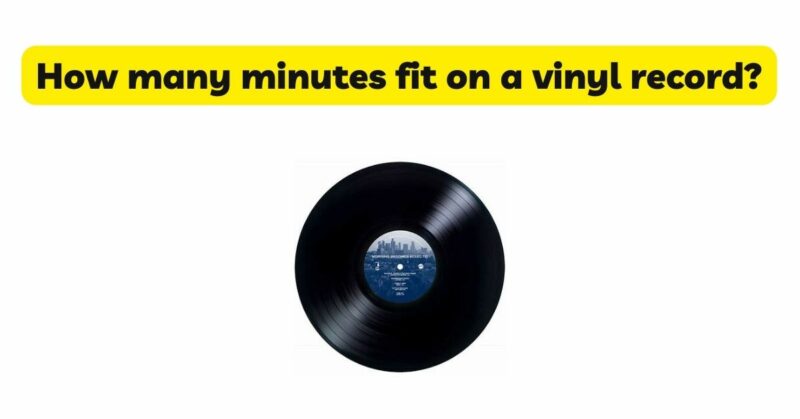The allure of vinyl records lies not only in their unique sound quality but also in the tangible experience they offer. As vinyl continues to captivate music enthusiasts, one question that often arises is how many minutes of music can fit on a vinyl record. In this article, we will delve into the intricacies of vinyl record duration and explore the factors that determine the length of music that can be pressed onto a single record. Let’s uncover the mysteries behind vinyl record duration.
- Vinyl Record Formats and Their Durations:
Vinyl records come in various formats, each with its own limitations and durations. The most common formats are 12-inch LPs (long-playing albums) and 7-inch singles. Understanding the durations associated with these formats is key to comprehending vinyl record limitations.
a. 12-inch LPs:
12-inch LPs are the standard format for full-length albums. They typically offer a longer playing time compared to other vinyl formats. The duration of music that can be pressed onto a 12-inch LP depends on the speed at which the record is played and the amount of music on each side.At the standard speed of 33 1/3 revolutions per minute (RPM), a 12-inch LP can typically hold around 22 to 24 minutes of music per side. This estimation allows for optimal sound quality and groove spacing, ensuring that the stylus can accurately track the music without compromising fidelity.It is important to note that pressing longer durations of music on a single side can result in a decrease in sound quality, as the grooves become closer together and the space for the stylus to track the music narrows. Consequently, longer albums may span across multiple LPs to maintain optimal sound quality and prevent distortion.
b. 7-inch Singles:
7-inch singles, also known as 45s, are smaller records that often contain one or two songs per side. Compared to 12-inch LPs, 7-inch singles have a significantly shorter duration due to their smaller size and faster playback speed.Played at 45 revolutions per minute (RPM), a 7-inch single typically holds around 3 to 5 minutes of music per side. This limited duration is a result of the smaller surface area available for grooves, as well as the need for higher playback speed to accommodate shorter songs.
- Factors Affecting Vinyl Record Duration:
Several factors influence the duration of music that can fit on a vinyl record, regardless of its format. These factors can impact the quality of sound reproduction and play an essential role in determining the maximum duration achievable.
a. Groove Spacing and Sound Quality:
The spacing between grooves on a vinyl record is crucial for accurate playback and sound quality. As the duration of music increases, the grooves must be spaced closer together, reducing the available space for the stylus to track the music.Pressing longer durations onto a single side can result in narrower grooves, which may compromise sound quality. The stylus needs enough room to accurately follow the grooves, and excessively narrow grooves can lead to distortion or tracking issues.
b. Audio Fidelity and Dynamic Range:
Vinyl records are prized for their warm and rich sound quality. However, achieving optimal audio fidelity and dynamic range becomes challenging when pressing longer durations onto a single record side.To maintain audio fidelity, the dynamic range (the difference between the softest and loudest parts of the music) needs to be carefully balanced. When the dynamic range is compressed to fit more music onto a side, the overall sound quality may suffer.
c. Record Thickness and Weight:
The thickness and weight of the vinyl record also play a role in its duration limitations. Thicker and heavier records allow fordeeper grooves, which can accommodate longer durations of music. Thinner records, on the other hand, have more limited space for grooves and are better suited for shorter durations.
- Album Length and Multiple LPs:
While the duration of music that can fit on a vinyl record is limited, artists and labels often release albums that exceed the maximum duration per side. In such cases, albums are typically spread across multiple LPs to maintain optimal sound quality and fidelity.Splitting a longer album into multiple LPs allows for wider grooves and reduces the risk of distortion or tracking issues. This approach ensures that each LP can deliver the best possible sound reproduction.
Conclusion:
Vinyl records have a finite capacity for music, and the duration that can fit on a record is influenced by various factors, including format, groove spacing, audio fidelity, and record thickness. 12-inch LPs typically hold around 22 to 24 minutes of music per side, while 7-inch singles accommodate 3 to 5 minutes per side.Maintaining optimal sound quality and fidelity is crucial when pressing vinyl records, and exceeding the recommended durations can lead to compromises in sound reproduction. As a result, longer albums are often spread across multiple LPs.While vinyl record duration has its limitations, it is precisely these limitations that contribute to the unique experience and charm of vinyl. Vinyl enthusiasts embrace the tactile nature of the format and appreciate the art of selecting and listening to albums as intended.Understanding the duration limitations of vinyl records allows music lovers to appreciate the craftsmanship involved in preserving audio quality within the confines of physical limitations. So, whether it’s a concise single or an epic double LP, the allure of vinyl continues to captivate audiences, celebrating both the music and the medium.

